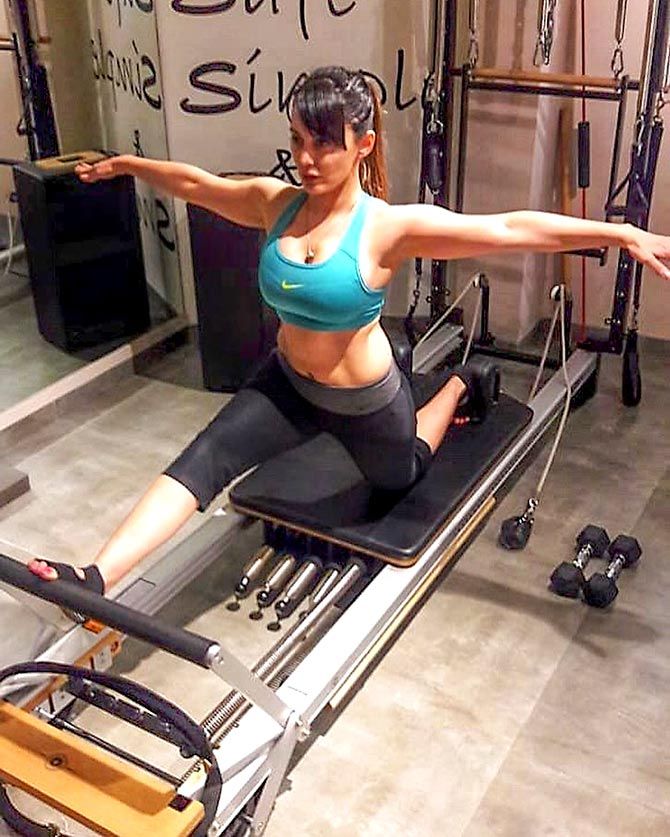 | « Back to article | Print this article |
It is important that you listen to your body and understand the difference between getting too sore and doing just what is right, says Shrey Khanna.

A lot of you may still be working out to get that perfect summer body.
While summers are great for intense workouts and favourable in achieving optimum results, it is also the perfect time to take precautions and avoid muscle injuries and fatigue.
Here are a few tips to keep in mind so you can make the most out of summers.
Exercise approach
Attacking too much weight, too soon is not recommended.
Poor form, swinging the weight, using momentum are instances indicating that you may be using too much weight.
Greater momentum increases the potential of injury and reduces the effectiveness to the muscle group being targeted.
Measure the effectiveness of workouts by how sore you are.
Soreness is not the only indicator of growth, it's also an indicator of muscle damage.
It is important that you listen to your body and understand the difference between getting too sore and doing just what is right.
Avoid highly technical movements if you aren't comfortable.
If you are a beginner, it's stupid to get into squatting or deadlifting within the first few sessions. You will first need to learn the movement pattern and the art to perform the lift.
You could start with stable machines and gradually take it up higher.
Use an app to measure total kcal/macros as a tool to adjust changes in scale weight and use workouts as a tool for gaining muscle. Gaining muscle is the main aim of the workouts.
Start with a structured program with more of circuit weight equipment (machine based).
As an unconditioned beginner with less integrity in joints and less stability in the core which supports the entire body during training, using machines provides support for these weaker areas allowing the intended muscle to be isolated and strengthened before progressing to weights. Example: lat pull down, seated rowing, chest press, leg press, leg curls, extensions etc.
Start with a weight from which you can perform at least 12 to 15 reps with proper posture comfortably.
The weight can be heavy enough to tire the muscle and individual might be unable to continue without a 30 to 90 second rest period.
If you can perform more than 15 reps with a certain weight, it's better to increase the weight.
Focus on performing the same exercise routine and sticking to it. Learn the movement patterns, rather than switching up the exercises often.
Strength is a skill and you get better at a skill with consistent practice. It's better to pick an exercise movement which is in your plan and keep progressing on it for months before trying for 100 variants of the same movement.
Progress doesn't come in a linear fashion. Increase the absolute weight lifted, total reps and sets, reducing rate of perceived exertion, quality/form of the movement improving all count as one progresses.
When you start noting down your weight and reps you lifted, you have clear idea if you are progressing or not.
Without a workout log, you can never be sure that you made a progress or not.
Rather than fixing the actual issue you tend to blame it over plateau and then move away in hope that someday something magical will happen.
You can choose a frequency of 3 to 4 workouts per week and make optimal progress.
As you are relatively new to lifting and the stimulus needed for optimal progress can be achieved with 3-4 days of lifting per week by concentrating on whole body workouts or an upper-lower split as opposed to the 'bro-splits' which are just a single muscle group.
As a beginner you don't need a lot of volume (sets x reps x weight lifted) for a particular muscle group, in one single day. Sets with 8 to 20 reps seem a good ballpark for almost all lifts, being at the higher ends with the smaller muscle groups.
Single weight progression is something in which you keep on increasing weight to the bar. This progression works best for the beginners.
Since they can adapt to the load quickly it's a good idea to linearly add the weight to the bar.
It does have limitations that you cannot scale the weight limitless, there will be a stop at some point.
Example:
Session 1 : 40 kg -- 3(Sets) X 10 (reps)
Session 2 : 42.5 kg -- 3 X 10
Session 3 : 42.5 kg -- 3 X 10
Session 4 : 45 kg -- 3 X 10
Session 5 : 45 kg -- 3 X 10
Session 6 : 47.5 kg -- 3 X 10
Nutrition approach
If you feel you are way out of shape and need to lose a considerable amount of fat, choosing a deficit in term of total kcal is a good idea.
The total deficit can be adjusted from time to time to suit the rate of fat loss needed, aiming at roughly 0.5 to 1 per cent of total body weight loss per week in kg.
If you feel you are just slightly out of shape, you would do better with body recomposition as a goal, take maintenance kcal as an approach as you will make great muscular development and lose fat at the same time.
 Lead image used for representational purposes only.
Lead image used for representational purposes only.
Shrey Khanna is health coach, nutrition and wellness consultant at Fittr, an online transformation platform.